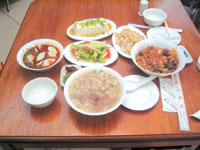|
Shaanxi special
By Ye Jun ( Beijing Weekend)
Updated: 2004-02-05 14:43
 What brings customers to the Tongshengxiang Pao Mo Restaurant, if not fond memories of food in the past, must be curiosity. What brings customers to the Tongshengxiang Pao Mo Restaurant, if not fond memories of food in the past, must be curiosity.
The popularity of Pao Mo, one of the most famous styles of food in Northwest China's Shaanxi Province, among Beijing locals, was clearly indicated by the sparsely seated main dining hall.
On the weekday I went there, customers attracted to this restaurant located behind the Beijing Hotel occupied less than one third of the 30 tables in the big ground floor hall.
Yet the name Tongshengxiang is among the oldest restaurant names in China, founded in 1909 in Xi'an, the capital of Shaanxi.
The old restaurant set up its Beijing branch jointly with the Beijing Hotel in 1991.
Hence the restaurant's beautiful-looking menu, with English names of the dishes, although not without spelling mistakes. The waiters and waitresses are decently dressed.
The reason the restaurant does not attract more customers, though, is probably not that the food is not good, but that people are not familiar with it.
For the northern Chinese, most of whom tend to love tasty food with a relatively strong flavour, Pao Mo is ideal.
"Pao" means "soak" in Chinese while "Mo" means "flour cake." Simply put, Pao Mo is made by boiling shredded half-cooked flour cake in a very hot beef or lamb broth. It is served with some beef or lamb slices inside, which customers choose themselves, and some starch noodles, both boiled soft. There is also some vegetables.
For people who are used to the flavour of Pao Mo in Shaanxi, they might think the soup in the restaurant is not hot enough, not oily enough and the taste is not strong enough.
But for people who are not from the province, and especially for expats, it is ideal: the temperature of the soup is such you can eat it right away, the cake and meat are tasty, but not very salty or oily.
The food has been slightly adapted to fit the local appetite.
Pao Mo is an "interactive" food. After you decide on Pao Mo with beef or lamb, you will be asked whether you prefer to shred the half-done cake yourself.
Shredding the cake yourself is a tradition with the historic food. Doing so is believed to add flavour to it.
I chose Pao Mo with beef, with which is served on a plate containing a small amount of chopped cilantro, mildly spicy red pepper sauce and pickled sweet garlic.
There is an option of Pao Mo with hot sauce, which is much spicier and very tasty.
The menu warns that the Pao Mo should not be stirred when you have it-it will reduce the flavour!
Because the Pao Mo is hot, we ordered three cold dishes to go with it: a bean curd with spring onion and slightly salty sauce, bamboo shoots with shrimp roe and vegetable salad that contained chopped cucumber, tomato and slices of green pepper and onion. These tasted good.
The meal cost 82 yuan (US$10). The quantity is a little more than two people can finish.
Other typical Northwestern Chinese food on the menu includes juicy mutton steamed dumplings and boiled dumplings served in spicy and sour soup.
The restaurant serves a wide range of other dishes including seafood, cold and hot dishes. But because it is Islamic, there is no pork on the menu. There are a lot of beef and lamb dishes and some chicken and duck ones.
A bowl of Pao Mo costs 15 yuan (US$1.8), but Pao Mo with hot sauce costs 20 (US$2.4). It's a reasonably priced restaurant with most dishes priced from 6 to 25 yuan (US$0.7-3). The most expensive dish is a soup of bamboo shoot-wrapped abalone slices, which costs 89 yuan (US$11).
How to go there: enter Xiagongfu Jie from entrance on Wangfujing Daijie opposite Oriental Plaza behind the Beijing Hotel. Walk on 50 metres and find the restaurant on the right.
Address of Beijing Hotel: 33, Dongchang'an Jie, Dongcheng District.
Tel: 6513-7766 ext. 1380
|
